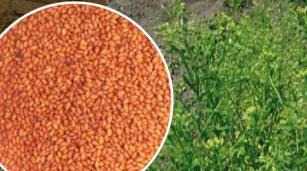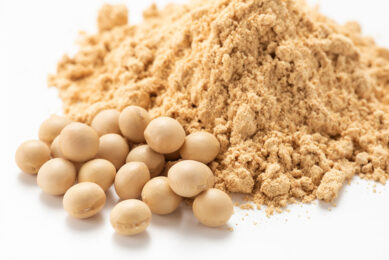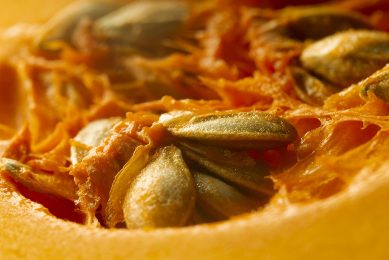By Dick Ziggers
Camelina, otherwise known as “gold of pleasure” or “false flax” has been grown in Europe for centuries and in the
Iron and Bronze ages was an important agricultural crop. From the Roman Empire until the discovery of gas and electricity, this oil was the favourite for use in oil lamps and also a common edible product. Camelina sativa belongs to the same family as oilseed rape (Cruciferae or Brassicaceae), but is a different genus. Camelina meal is a by-product of camelina oil extraction. The oil is a potential source for biofuels. Sustainable Oils, a joint-venture between Targeted Growth and Green Earth Fuels, was launched in late 2007 and is focused on the research, development and commercialisation of camelina for biodiesel production. Camelina requires minimal water and can be harvested with traditional equipment. Because of these properties, it can be grown on fallow ground or as a rotation crop. Therefore, it is not competitive with traditional food crops but instead creates a ‘food-plus-fuels’ scenario.
“This is an important step in the process of developing a strong, sustainable market for camelina production,” said Steve Sandroni, production and logistics manager, Sustainable Oils. “Opening up the livestock feed opportunities for camelina meal provides a market for the most significant by-product of camelina oil production. Particularly at a time when livestock feeders are battling high input prices, camelina meal can be a very attractive option,” he continued. “The meal is an excellent source of protein. With protein levels of 40% or more, it is similar to soybean meal but offers the added benefit of being high in omega-3 fatty acids.”
Seed characteristics
The seeds of camelina are of course the most important part of the plant for biofuels and feed use. The seeds are very small, and one kg contains more than one million seeds. Seeds contain 29-39% oil and 23-30% protein. Oil is composed of 12% saturated fatty acids, which is quite low and has potential for good edible oil. Furthermore, the oil contains 54% polyunsaturated fatty acids (pufa), which is quite high. This makes the oil susceptible to auto-oxidation and shortens shelf life. 34% of the oil is monounsaturated of which 2-4% erucic acid. The oil has a substantial amount of linoleic acid, is high in eicosenoic acid and low in glucosinates. The high linolenic content is important to biodiesel production, since it gives the product a pour point of around -26ºC, which is considerably lower than other oils offered, and is important for users in colder parts of the world. Camelina meal is comparable to soybean meal, with around 45-47% crude protein and 10-11% fibre. Camelina oil can be used as edible and industrial oil (including biofuels). The only necessary treatment for the oil prior to deodorisation is filtration. No neutralisation or bleaching is required, which saves costs and energy and avoids polluting by-products. It can be used in animal and bird feed, cosmetics (skin care products), linoleum (high linoleic acid content), and even as an ornamental crop (dried flowers).
Yield improvement
To be able to use camelina oil for biodiesel in an economical way yields have to increase. In the US state of Montana researchers have been working on this by optimising nitrogen and phosphorus inputs. This raised oil yields to 1,200 pounds per acre (1,340 kg/ha). According to Sam Huttenbauer, CEO of Great Plains (The Camelina Company), camelina can be grown in a rotation of wheat crops. Farmers, who have followed a wheat-fallow pattern, as is often seen in Washington and Oregon, can switch to a wheatcamelina- wheat pattern, and realise up to 900 litres of camelina oil per acre, and gain up to 15% more productivity on the wheat. The high cost of camelina had been preventing further investment in the crop’s production, but with current feed or fuel crops in competition, Sustainable Oils intends to develop a 100 million gallon/year (378 million litres) biodiesel plant in Montana, using camelina as a feedstock. The venture plans to sign up to fifty Montana farmers to grow the feedstock. Dr. Bill Schillinger at Washington State University recently described camelina’s business model. He calculated that with 1,400 pounds of seed per acre at 16 cents a pound, camelina would bring in $224 per acre; 28-bushel white wheat at $8.23 per bushel would garner $230. Wheat has come down since then, so camelina is more attractive.
Use as feed stock
Camelina has one more advantage – a meal by-product that can be successfully used in beef, dairy, poultry and fish rations. Cold-pressed camelina meal contains a residual oil of 8 to 11% and this oil contains 34 to 38% omega 3 fatty acids and very high levels of vitamin E. The meal is also an excellent source of protein and is very low in ash content. Beef feeding trials are currently underway at Montana State University that show feedlot daily rates of gain were higher with a ration containing 3.5% camelina meal than rations containing 3.5 and 7.0% soybean meal.
Researchers at Utah State University Cooperative Extension carried out a study (2007) using camelina in turkey starter diets. Results indicate that camelina meal may be a potentially useful minor ingredient in turkey diets if economically feasible, but caution should be exercised in using it above 5% of finished feed in a poultry starter diet. In an appended test, similar weight gain and feed conversion were attained with a diet containing camelina oil as a replacement for the generally used vegetable oil compared with the control diet. French researcher at INRA in Rennes looked at the effect of camelina on milk fatty acid composition and butter spreadability (2007).
The nutritional and rheological properties of butter depend on the fatty acid composition of milk. Therefore, feeding oilseeds rich in unsaturated fatty acids is likely to affect butter properties. They compared a control diet composed of 60% corn silage and completed with high-energy and nitrogenous concentrates to two experimental diets designed to provide the same amount of polyunsaturated fatty acids via either camelina seed (630 g/d, CS diet) or camelina meal (2 kg/d, CM diet). The camelina diets tended to decrease dry matter intake but did not have a significant effect on milk production. They generated a slight decrease in milk protein and a strong decrease in milk fat yield and content.
The CM diet led to a stronger decrease in fat content than the CS diet. Camelina generated a greater proportion of monounsaturated fatty acids with the CM diet. Camelina also led to an increase in conjugated linoleic acids. Camelina did not affect parameters of butter making except churning time with milk from CM fed cows, which was longer. The butters of camelina diets were softer at all temperatures tested, especially with the CM diet. From the results the researchers concluded that feeding camelina can modify milk fatty acid profile and butter spreadability. In Finland, camelina expeller cake was studied (2006) in a trial with broilers to examine the effects on performance and meat quality. Camelina expeller reduced the growth of the birds linearly. It also depressed their feed intake and feed conversion ratio during the starter phase (1-14 days).
Feeding of camelina significantly increased the omega- 3 fatty acid level in broiler meat. This was mainly due to an increase in linolenic acid. Feeding did not seem to have any adverse effect on the sensory quality of broiler meat. Meat from female broilers which received 5% camelina expeller in the diet was significantly more tender than meat produced by feeding 10% of the ingredient.
Source: Feed Tech magazine Volume 12. No. 9












